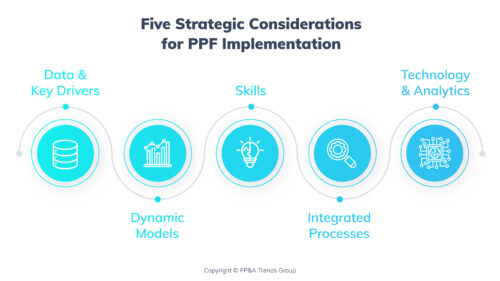
FP&A and data mastery: A blueprint for excellence
Financial Planning and Analysis (FP&A) is pivotal in today’s dynamic business environment, facilitating data-driven decision-making.…

In today’s fast-paced business environment, uncertainty is a constant challenge. Traditional planning methods are often inadequate. Predictive planning and forecasting (PPF) has become essential for businesses aiming to stay ahead in the current market. This dynamic approach enhances agility and adaptability in decision-making and provides a robust way to plan for and manage uncertainty.
PPF leverages data analytics and machine learning to forecast future outcomes, enabling businesses to make informed decisions and adapt to changing conditions.
PPF transforms data into actionable insights through scenario planning. By integrating data analytics, statistical methods, and machine learning, PPF predicts future outcomes and prepares businesses for various potential futures. It supports on-demand re-forecasting when key assumptions change, using dynamic models to identify the key business drivers. This helps companies adapt swiftly to both internal and external changes.
PPF can operate on different maturity levels, from basic Excel-based models to advanced systems with predictive analytics, AI, and sophisticated technology platforms. Even at the basic stages, PPF demonstrates significant improvements over static forecast methods like last year plus 10%.
By adopting PPF, organizations transition from a static planning approach to an agile, data-driven one, which enhances their ability to make strategic decisions, optimize resources, and mitigate risks effectively.
PPF is crucial for several reasons:
Members of the International FP&A Board have shared their insights on PPF in different industries at various global locations.
PPF helps forecast sales trends, optimize inventory levels, and adjust purchasing patterns in real time. A CFO from the retail industry shared the following insight:
“By analyzing customer data, we can predict high-demand periods and adjust stock levels accordingly, preventing overstock and stockouts. This approach aligns inventory management with financial strategy, improving cash flow and reducing holding costs.“
PPF predicts production bottlenecks and schedules maintenance to minimize downtime. A VP Finance in manufacturing noted:
“PPF allows us to forecast equipment failures and plan preventive maintenance, ensuring continuous production. This proactive approach reduces unexpected costs and improves asset utilization, directly impacting our bottom line.“
PPF helps understand market shifts and consumer preferences, guiding product development and marketing strategies. A Finance Executive from an FMCG company remarked:
“By analyzing consumer behavior data, we can anticipate new trends and launch products that meet emerging demands. This alignment of product strategy with financial objectives helps optimize marketing spend and improve return on investment.“
An integrated PPF model shows how changes in a strategic plan automatically impact operational and financial aspects. For example, a change in marketing strategy will filter updates immediately into production schedules and financial projections, ensuring all departments are aligned and financial targets are met. This holistic approach enhances Strategic Planning and financial performance.
Our research shows that organizations typically progress through five stages of PPF maturity, each incorporating more sophisticated models and technologies. This simplified model helps you understand where you are and allows you to plan your organization’s transformation.
As organizations advance through these stages, the FP&A team evolves from a data consolidator to a strategic business partner, leveraging storytelling with data.

Figure 1
Each organization will be at a different stage of PPF maturity. Depending on where you are, you can start planning the transformative steps for your company. Implementing PPF involves five strategic considerations:
Depending on your current stage of PPF maturity, consider taking some of these steps to guide your organization toward more advanced and integrated forecasting.
The PPF framework is a strategic necessity for organizations aiming to thrive in a dynamic market. Follow these clear steps to implement PPF effectively:
By following these steps, FP&A departments can transform into dynamic strategic entities, enabling businesses to stay ahead in an unpredictable market. This transformation, from data consolidation to strategic partnering, can help companies navigate the complexities of the current business environment.